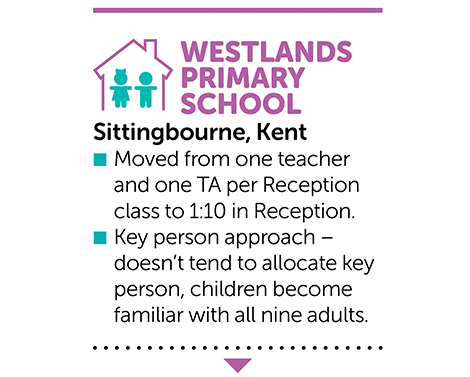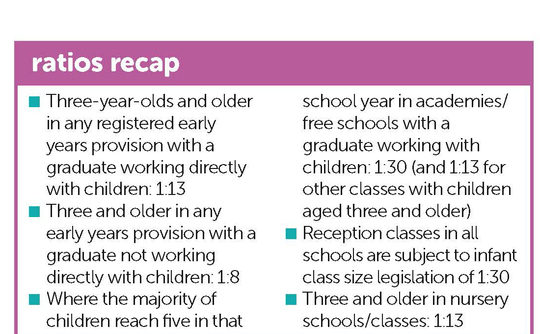
Download the pdf of this article
Could the revision of the EYFS present another opportunity to change ratios? For many, the jump from 1:8 for three- and four-year-olds in PVI settings to 1:13 and 1:30 in Reception is a problem.
For trainer and consultant Anne Gladstone, the drop in adult to child ratios from pre-school to Reception is a ‘massive issue’.
‘The drop from 1:8 to 1:13 or 1:30 comes at a time when children, many of whom will be aged four, are adapting to a new environment and change of routine.
‘Some children may not be toilet trained, while others, likely a minority, may not have been away from their parents for a prolonged amount of time.’
This makes implementing the EYFS, and meeting the individual needs of the child, challenging, she says.
‘Back in the 1990s when I started teaching a class, I had 35 children. That was the most difficult thing. I ended up doing crowd control.
‘You can’t implement the EYFS effectively on a 1:30 ratio if you are committed to good developmental, appropriate practice. How can you have conversations with parents? How can you encourage risk-taking?'
So what does this mean for key people?
‘Most people with vast quantities of key children, we are talking 15/16, say you don’t manage it. There are children who will just get on with it, but that isn’t good enough’, argues Ms Gladstone.
‘The first sentence of the EYFS states that staffing must meet the needs of all children, but that is not possible at 1:30. What if a child needs a cuddle and the teacher needs to speak with their parents in the morning? What happens if there are a few children crying? While there may be other adults around to provide comfort, it won’t be their key person, the person they are most secure with.’
However, according to Sue Robb, head of early years at Action for Children and a former head teacher, most schools have at least two adults in their Reception classes, which she believes is needed to implement the EYFS properly.

Westlands Primary School has doubled the number of teaching assistants – now with one teacher and two teaching assistants to three classes of 30.
Head of the school Victoria Pettett says, ‘With more adults we are able to have smaller phonics and maths groups, set to the children’s abilities. This has meant we are able to challenge the more able children, for example.
‘We can have more adult-directed activities during free-flow with staff scaffolding children’s learning and bringing learning forward. PSED and language is low in the school overall so being able to have an adult in the role-play area, giving the children ideas for play and helping them to share, has helped.
‘Five years ago, we had one teacher and one teaching assistant to each Reception class. At this time, the Baseline data showed gaps in children’s learning. Increasing the number of adults has made a difference.
‘We don’t tend to allocate a child to a member of staff as we want the children to become familiar with all nine adults.
‘All the children mix during free-flow so we recognise that children may gravitate to other adults than those in their class. We go with the children’s needs.’
The way the Reception class uses teaching assistants means that teachers can focus on planning sessions and children’s assessment.
‘Our teaching assistants support with PSED, settling children in the mornings and building relationships with families’, says Mrs Pettett.
‘While all staff can make observations of children by taking photos on our iPads and uploading them to the app we use to track children’s development, it is teachers who use this information to assess children’s learning.’

Richmond Avenue has moved to operating above statutory ratios with a minimum of six adults – two teachers and four teaching assistants – to 60 children.
Under the new system, all staff focus on six children, 10 per cent of the cohort, a week. However, if a child shows a strong bond towards a particular person, the relationship is encouraged.
EYFS lead Leah Morris explains, ‘Every staff member knows each week who the “focus children” are and they all work with them.
‘We rota in time at the end of the school day for one member of staff to write up focus-child observations.’
Ms Morris says they also give these children cameras to take home for a week to take photos of things they are doing, trips out and so on. After the week, the children bring the cameras back to school to share their photos with the rest of the unit. Staff decide who will share all the focus children’s pictures of the week with everyone else.
The following week, those parents come in for a parents’ evening. As of last September, this replaced traditional parents’ evenings in Reception, which used to take place three times a year.
The nursery based in the school in Southend-on-Sea also holds focus-child parents’ evenings now, led by a child’s key person.
‘Under the new system, there are more opportunities for parents to speak with us, which has meant we have got to know parents better’, explains Ms Morris, who says the focus-child approach is one of a number of measures (including increasing the number of staff and stopping whole-class teaching) taken after the school was graded as ‘requires improvement’ by Ofsted in 2013. The school is now rated Good.
She says the school puts ‘all our resources’ in the early years to boost attainment further up the school.
‘Previously when we had just four adults in the unit there wasn’t the opportunity for meaningful interactions as staff had to make toilet trips with the children and deal with accidents. It also meant that when staff took their breaks, children had to leave their environment for whole-class teaching,’ she says.
‘Now, two members of staff are always rotated outside each day. Another member of staff does reading only with the children, while someone else deals solely with accidents and emergencies. Staff change roles daily.’
Ms Morris says this was made possible by the school’s head, who understands the importance of early years and believes in higher ratios.
REVISING RATIOS
While there appears to be a case for adult to child ratios to be increased in Reception, Ms Robb says she doesn’t think revision of ratios is on the Department for Education’s radar. Even if it was, she says, it would be difficult to know what ratio would be right.
‘There are lots of different models. Some schools mix nursery and Reception, some work as a unit, while in others there is just one class’, she explains.
‘It also depends on the cohort of children and the environment. Some schools might not do free-flow in Reception. Some might be in older buildings which don’t have direct access to outside so need another adult.
‘What’s right for September might not be right for July. When I was a head, we followed the needs of the children. We had more adults before Christmas and fewer adults in the summer as the children became more independent.
‘I see 1:13 working OK in Reception. 1:8 is very high, given that some children are age five.’
Jan Dubiel, national director of Early Excellence, is also not convinced that a change in ratios is needed or would result in best practice. He says best practice is more dependent on the quality of staff.
‘In Reception you need high-quality interaction, pedagogy and the skill of those that work with children’, he explains.
‘The Effective Pre-school Provision Evaluation (EPPE) tells us that the most effective early years settings have a fusion between adult- and child-led activities. It is critical that adults support child-led activities.’
See the online edition for more on ratios in PVI settings
RATIOS RECAP

Could ratios go the other way?
Back in 2013, then education and childcare minister Elizabeth Truss put forward plans to relax ratios for pre-school children. Proposals were to increase the ratio for babies and one-year-olds to 1:4 (up from the current 1:3 ratio), and to 1:6 for two-year-olds (currently 1:4), as well as encourage more 1:13 teacher-led sessions for three and four-year-olds in nurseries.
The Government said it would result in lower childcare costs for parents. But the deeply unpopular policy was ditched after opposition within the coalition following months of campaigning by the sector and parents.
Some in the sector fear the ratios debate will be revisited. Property experts Christie and Co has said it is ‘convinced’ there will be a renewed push to raise the ratios this year and is planning a report into the issue of European ratios for the autumn. Writing for Nursery World, childcare managing director Courteney Donaldson said rises in operational costs and flat 30 hours rates from central government ‘will reignite the ratios debate’. Writing for Nursery World online, she said ‘A reduction in staffing ratios is likely to be positioned by the government as being a proactive measure to assist business owners to mitigate expense, which in turn could offset the calls for future fee increases. Evidence demonstrating that a reduced ratio does not impact on ‘quality outcomes for children’ will undoubtedly be sourced by government to support announced reduction in ratios.’
The Government has in the past indicated it thinks there is room for manoeuvre on ratios. A DfE review of childcare delivery costs in 2015 also concluded a typical provider could save around 15 per cent by staffing to ratio, and using ‘variable staffing models’. The childcare section of the Conservatives’ 2017 manifesto has also been taken as an allusion to ratios by some: ‘The Conservative government will introduce, this year, thirty hours of free childcare … We will go further. The next Conservative Government will assess what more is needed, including looking at the best ways that childcare is provided elsewhere in Europe and the world.’ And just last year, the DfE allowed childminders delivering wrap-a-round care for three and four-year-olds to invoke an EYFS exception to the usual staff to adult ratio of 1:3 for under-fives if they were taking up a 30 hours place at a school.









